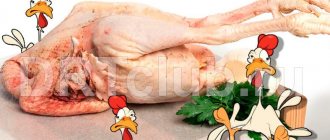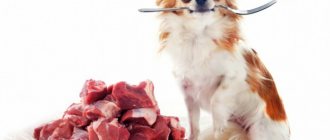Feeding dogs
Both puppy and adult Chihuahua dogs need to eat well. What to feed a chihuahua. A diet that meets the necessary requirements keeps the dog in good shape and promotes the development and formation of the puppy’s body. In this case, we are primarily talking about the quality and composition of the food offered to the animal.
What to feed a chihuahua
Is it possible to give a dog chicken bones and offal without harming its health?
Very often, pet owners, without having all the information, say: “What's wrong with giving my dog chicken bones? In a couple of hours, gastric juice will turn them into a soft mass - and no problems will arise.” Unfortunately, it's not that simple. The “soft mass,” according to experts, will be similar in structure to a piece of rubber, not so harmless, and even a few minutes (not to mention two hours) will be enough for the sharp bones to get into the animal’s stomach and cause irreparable harm to the pet. Let's look at the problem in detail.
Can I give my dog chicken bones?
Veterinarians are unanimous in answering this question: chicken bones should not be on a pet’s menu. Tubular bones (they are found in the paws and wings of chickens) seem quite tender and safe - the dog will happily chew them . In this case, however, many small sharp pieces are formed, which, once in the esophagus, stomach and intestines, can pierce them. The consequences are perforation, peritonitis, a complex operation, the outcome of which can be tragic. In the practice of veterinarians, there are cases when a bone got stuck in a dog’s throat and the problem could not be solved without surgical intervention. Is it worth risking the life and health of your pet?
And one more circumstance must be kept in mind: in poultry farms, chickens lead a sedentary lifestyle, which leads to the development of inflammatory processes in bone tissue. This problem will not affect a person - after all, he only eats meat, and the infection does not spread in him. If you give a bone to an animal, the likelihood of infection in its body becomes real. By the way, even heat treatment does not help: during cooking, toxins are released from the infected tissue that can cause poisoning of the animal.
Why you shouldn't give your dog boiled chicken bones
A big mistake pet owners make is feeding them boiled chicken bones. Particularly dangerous are the bones from chicken that was boiled to make jellied meat. This process is long, the bones become soft, and it would seem that they belong in a dog’s bowl. The danger, which many owners are not even aware of, is that under the influence of gastric juice the bones turn into a tight, dense mass, which, once in the intestines, literally clogs it. Okay, if the portion of the “treat” was small, the pet’s body will be able to cope with it. If the dog gets a large amount of leftovers from the festive table, trouble will not be long in coming.
Giving chicken bones, even boiled, to dogs is strictly prohibited.
How to help your four-legged friend in this situation? Sometimes Vaseline oil and an enema are enough. In the most difficult cases, the participation of a veterinarian is required. Unfortunately, even surgical. And then – long-term postoperative care for the animal.
The only option that experts allow is to use a soft bone as a treat, when the dog has already thoroughly refreshed himself and filled his stomach with healthy food. The pet will not greedily nibble and swallow the treat, but will stretch out the pleasure for a long time.
Attention: when giving bones to a dog, owners believe that it is good for the animal’s teeth. In fact, this is not always the case - in adult dogs that chew bones, their teeth wear down very quickly.
Is it possible to give your dog chicken feet?
The main problem is that chicken feet (if given whole) contain dangerous tubular bones, and in addition to them, they also have rather sharp claws. To make the product safe for the dog, jellied meat is boiled from the paws, removing both bones and claws from it (when it is ready). You will have to tinker, but your pet will receive tasty and, most importantly, healthy food. For puppies, this is an excellent supplement that strengthens the growing body, especially the joints. True, it is not recommended to partake of such treats. Everything is good in moderation.
If you give your pet raw chicken feet, you must follow the following rules:
- remove the bones from them, cut off the claws, scald them with boiling water, do not give them “pure”, be sure to mix them with porridge.
Can I give my dog turkey bones?
Turkey tubular bones (in the paws, thighs, wings of the bird), as well as chicken bones, should not be given to dogs. They also have an “aggravating circumstance”: the turkey is a large bird, it is slaughtered at the age of two to three years, so its bones are larger and stronger than those of a chicken, and their fragments can be especially dangerous.
Turkey bones may be more dangerous than chicken bones.
As for the neck and the bones it contains, this is an excellent food for a four-legged pet. Turkey meat is richer in vitamins and minerals than chicken, it is low-fat, hypoallergenic, and therefore can be specially recommended for our smaller brothers who have any problems with digesting food. There are no restrictions for dogs of different breeds, of any size. It is the practice of many breeders to start feeding puppies with turkey meat: first, the babies are given meat, which is very tender, tasty and easily digestible, and then necks.
Important: Regular consumption of turkey neck by a dog helps the pet get rid of plaque.
What is the best food for Chihuahuas?
After meeting the nominees, all you have to do is specifically select one product, taking into account the specified evaluation criteria, as well as the individual characteristics of your pet. Which product to buy will be determined by the final nominations from Vyborexperta.ru, compiled on the basis of the highlighted advantages:
- Royal Canin Chihuahua Adult is one of the most popular food for Chihuahuas without age restrictions for every day;
- Grandorf rabbit, lamb - the best food for Chihuahuas with allergies, a high percentage of meat with probiotics;
- Arden Grange Weaning/Puppy chicken for puppies – a rich composition to support the puppy’s growing body, vitamins and minerals, probiotics;
- Gemon tuna, chicken - easy to digest, moderate fat content, preventing overeating.
For full growth, development, and vital functions, a Chihuahua needs a diet that consists of 80% meat. Remember that veterinarians recommend using holistic, super-premium food. The optimal ratio of components, vitamins and microelements is noted here.
Is it possible to give a dog chicken liver?
Each product has its own pros and cons. When talking about the “disadvantages” of the liver, we must keep in mind that by-products (to which it belongs) act as a kind of filter in the body - they accumulate harmful substances - for example, antibiotics, hormones given by birds, as well as pesticides contained in feed. This means that Chicken liver can be given to your pet in limited quantities, preferably as a supplement rather than as a main food.
Chicken liver is best given to dogs as an additional supplement to their diet.
Among the “advantages” of chicken liver, it should be noted that it contains, and in large quantities, vitamin B12. Give your pet boiled liver, little by little (so as not to provoke an allergic reaction), no more than three times a week.
How much food should I give?
If you feed dry or canned food, then the manufacturer conscientiously indicates the daily dosage on the packaging. Proportions are indicated according to the age of the dog, so follow the table provided by the manufacturer.
If you feed your Chihuahua natural food prepared at home, then in determining the proportion of the amount of food, its nutritional value, in other words, its calorie content, is of fundamental importance.
A puppy's growing and active body expends more calories and therefore consumes more food than an adult. As you get older, your appetite decreases. It is also important to understand that the amount of calories in dry food and natural food varies greatly. Let’s say that if a table glass (200 grams) of natural food contains 100 kcal, then the same amount of dry food contains about 200 kcal. The figures are for informational purposes only; caloric content is calculated based on the actual ingredients in the food.
Is it possible to give a dog chicken meat?
Chicken meat is a suitable food for a four-legged pet. It contains vitamins, proteins and fats necessary for the growth and development of a dog. Experts, while recognizing its dietary characteristics, disagree on one question: should the meat be given raw or cooked? Raw food, of course, has more benefits, but there is a danger that it may be contaminated with salmonella. Experts recommend that when giving raw meat to an animal, be sure to scald it with boiling water. They also advise that when introducing chicken to your pet’s menu, do it carefully and observe the body’s reaction - some dogs may be allergic to this type of food.
Allowed and healthy products
Naturally, the list is huge, I don’t see the point in listing all the products, but I’ll touch on the main ones that you can pamper your pet with, and are available in almost every home:
- Vegetables:
carrots, cabbage, pumpkin, cucumber, tomato. - Fruits and berries:
green apple, melon, cranberry, watermelon, banana, raspberry, strawberry, wild strawberry, papaya (without peel and seeds), blueberries, gooseberries, dried apricots, currants, pear, tangerines, oranges. - Cereals:
buckwheat, rice, millet. Barley, rolled oats, oatmeal and semolina are practically not absorbed by the body, and can provoke intestinal volvulus. The richest porridge in minerals and easily digestible by the Chihuahua’s digestive system is buckwheat! - Dairy products:
cottage cheese, unleavened hard cheese, kefir, sour cream.
Fresh berries, fruits, vegetables and dairy products are served as treats in reasonable quantities and not often.
Cereals and vegetables are often used as a side dish when feeding natural foods. From vegetables, you can prepare a stew with pieces of lean (lean) meat, seasoned with sour cream or a small amount of olive oil. From cereals - porridge with meat or sea fish fillet. Vegetables can also be given raw as a light snack between meals. The optimal percentage of meat product in relation to the side dish: 60% meat versus 40% side dish. Salting and seasoning is prohibited!
Vary the menu if you feed your Chihuahua natural food to achieve maximum balance in the diet. It may be necessary to add specialized vitamin supplements (complexes) to food, but without recommendations and consultation with a veterinarian, independent initiative is inappropriate.
Is it possible to give chicken heads to a dog?
This part of the chicken is not prohibited for a four-legged pet, due to the fact that it does not contain tubular bones. The heads are given to dogs raw or boiled. A prerequisite is that the beak must be removed; if it is not removed, the dog may be injured or belch. Heads can be either a stand-alone food or an additive. If they are not boiled, then be sure to pour boiling water over them, cut them into small pieces, combine them with porridge or some vegetables, and add a little vegetable oil.
According to experts, this type of food is especially valuable for racing dogs; it provides them with the necessary nutrients contained mainly in chicken brain. The traditional rule remains relevant: before feeding your dog this type of offal, you need to make sure that it will not cause an allergic reaction in your pet.
Rating of food for Chihuahuas
First, we selected proven manufacturers recommended by leading veterinarians. Next, we studied the level of demand, and based on it we compiled a list of the most purchased goods. We compared the remaining applicants based on a number of characteristics:
- Composition, percentage of meat and other additives;
- Safety of the formulation, absence of synthetics, chemicals;
- Release format, granule size;
- Taste, smell;
- Category: holistic, super-premium, premium, economy;
- Age indications;
- Special needs of the animal;
- Energy value, nutritional value;
- Daily norm;
- Price, manufacturer's reliability.
The result of the comparative analysis was a top list of 8 positions. These are 4 nominees for adult dogs of the breed in question, 4 for puppies. Reviews from various authoritative sources helped to weed out products that were unreasonably expensive and of questionable quality, and identified the strengths and weaknesses of the leaders.
The best food for chow chow











